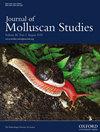When a genus must become two: resurrection of Pelagella Gray, 1850 with the description of six new species
IF 1.2
4区 生物学
Q2 MARINE & FRESHWATER BIOLOGY
引用次数: 1
Abstract
Goniodoris is the third most diverse genus of the nudibranch family Goniodorididae. The genus has undergone several taxonomic changes, with c. one-third of the recognized species of Goniodoris having been synonymized (most of these are junior synonyms of genera from other families). In addition, Goniodoris includes other synonymized genera within it, such as Pelagella, which was erected for Doris pareti. This species was synonymized with Goniodoris castanea and the genus Pelagella went almost unnoticed. In the present study, we investigate the systematics of the genus Goniodoris by examining specimens of G. castanea from England and Spain, G. joubini from Hawaii and six undescribed Goniodoris species from Australia, the Philippines and Mozambique. The morphology of the new species is studied using dissections of the internal organs and scanning electron micrographs of the radulae, labial cuticles and the penis. We also carried out phylogenetic analyses using partial DNA sequences of mitochondrial and nuclear genes. These analyses show that the type species of Goniodoris, G. nodosa, is not a member of the clade constituted by the focal species of our study; the valid name for this clade is Pelagella. Six new species of Pelagella, P. albopunctata n. sp., P. balanoyensis n. sp., P. longicornis n. sp., P. scottjohnsoni n. sp., P. rubrobranchiata n. sp. and P. vitrea n. sp., are described.当一个属必须变成两个时:Pelagella Gray的复活,1850年,描述了六个新物种
Gonidoris是裸鳃科Gonidoridae中种类第三多的属。该属经历了几次分类学上的变化,约三分之一的已知Goniodoris物种已被同义(其中大多数是其他科属的初级同义词)。此外,Goniodoris还包括其他同义属,如Pelagella,它是为Doris pareti而建的。该物种被命名为Goniodoris castanea,Pelagella属几乎无人注意。在本研究中,我们通过检查来自英国和西班牙的G.castanea、来自夏威夷的G.joubini和来自澳大利亚、菲律宾和莫桑比克的六个未描述的Goniodoris物种的标本,来研究Goniodois属的系统学。通过解剖内脏和扫描电子显微照片研究了新物种的形态。我们还利用线粒体和核基因的部分DNA序列进行了系统发育分析。这些分析表明,Goniodoris的模式种,结节G.nodosa,不是由我们研究的焦点物种组成的分支的成员;这个分支的有效名称是Pelagella。本文报道了Pelagella属的6个新种,白腹滨对虾(P.albopunctata n.sp.)、巴兰诺氏滨对虾(P.balanoyensis n.sp。
本文章由计算机程序翻译,如有差异,请以英文原文为准。
求助全文
约1分钟内获得全文
求助全文
来源期刊

Journal of Molluscan Studies
生物-动物学
CiteScore
3.00
自引率
8.30%
发文量
36
审稿时长
3 months
期刊介绍:
The Journal of Molluscan Studies accepts papers on all aspects of the study of molluscs. These include systematics, molecular genetics, palaeontology, ecology, evolution, and physiology. Where the topic is in a specialized field (e.g. parasitology, neurobiology, biochemistry, molecular biology), submissions will still be accepted as long as the mollusc is the principal focus of the study, and not incidental or simply a convenient experimental animal. Papers with a focus on fisheries biology, aquaculture, and control of molluscan pests will be accepted only if they include significant advances in molluscan biology. While systematic papers are encouraged, descriptions of single new taxa will only be considered if they include some ‘added value’, for example in the form of new information on anatomy or distribution, or if they are presented in the context of a systematic revision or phylogenetic analysis of the group.
 求助内容:
求助内容: 应助结果提醒方式:
应助结果提醒方式:


